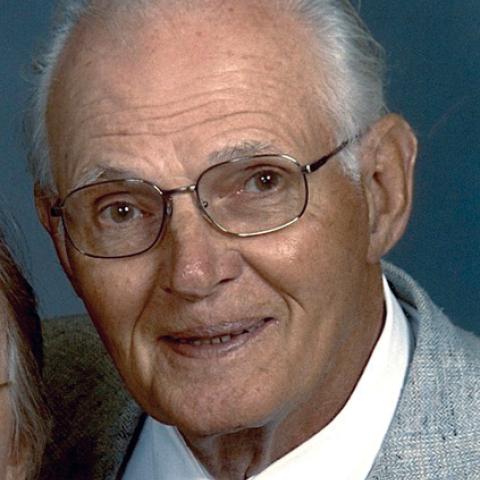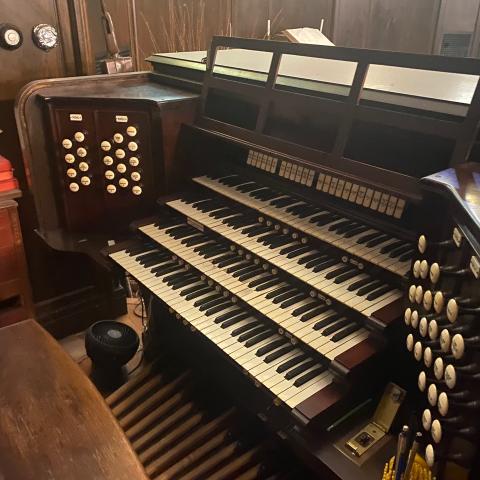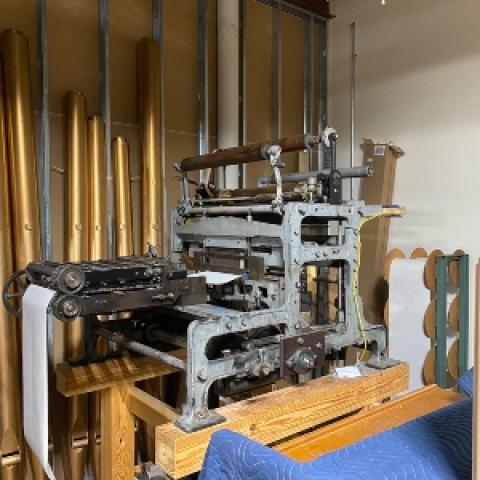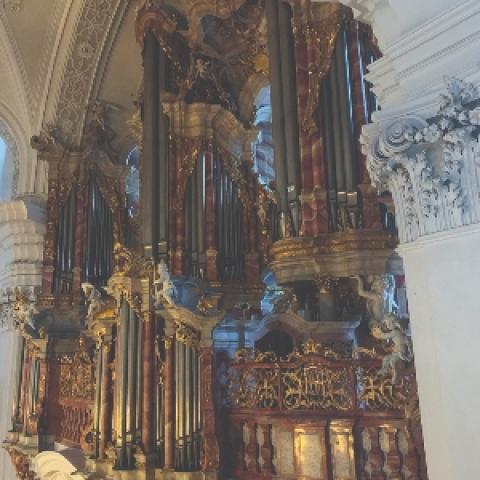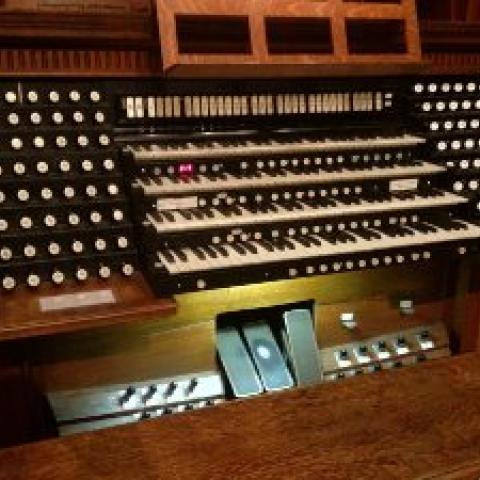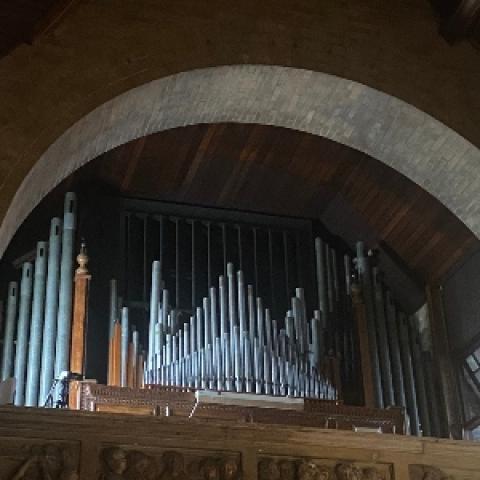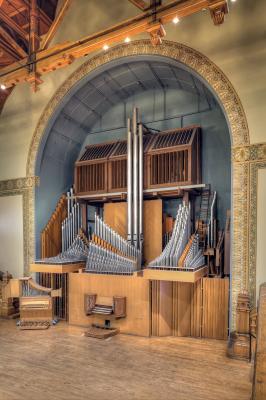
Walter Holtkamp and the American Classic
At the Organ Clearing House, we have been working on a Holtkamp organ these days, which has spurred me to remember the fleet of Holtkamps I have known and worked with. I spent my formative years working with John Leek in Oberlin, Ohio, starting when I was a student and John was the school’s organ and harpsichord technician, and continuing after my graduation and after John left the school to form his own company. We built several harpsichords and one complete organ together, and we worked through countless service calls, releathering projects, major repairs, and organ relocations. John had apprenticed and started his career in Holland and immigrated to the United States to work with Walter Holtkamp, Sr. (1895–1962). While working on Holtkamp organs at the Oberlin Conservatory of Music, he learned that the school was looking for a full-time technician and felt that was the job for him.
John had an active organ maintenance business, and given the proximity to Cleveland, the home of the Holtkamp Organ Company, we worked on dozens of their instruments. Oberlin professor Garth Peacock was organist at the Unitarian Universalist Church in Rocky River, Ohio, a 1950s brick building known affectionately (or otherwise) as “The Blue Whale,” where after several unheated service calls for the three-manual Holtkamp, we arrived for a tuning to find the sexton chortling, “I’ve got it good and hot in there for you this time!” Jack Russell was the organ teacher at Wooster College, where the big Holtkamp in the chapel was housed in a cinderblock corral. And David Dunkel, who graduated from Oberlin a few years before me, was organist at Saint Philomena’s Church in East Cleveland where Holtkamp had built an organ with an exposed Rückpositiv in 1936, touted as one of the first Rückpositivs in the United States.
I have written often and recently about the three-manual Holtkamp (1956) in Saint John’s Chapel of the Episcopal Divinity School, formerly the Episcopal Theological School (now defunct) in Cambridge, Massachusetts, where my father taught homiletics, and where I had my first organ lessons in 1968. Melville Smith, director of the Longy School of Music in Cambridge, was organist of the seminary and a strong advocate of Holtkamp organs. Charles Fisk was an apprentice in the Holtkamp shop, E. Power Biggs was a neighbor of the seminary, and the innovative design of that organ must have attracted a lot of attention.
Recently, the Organ Clearing House was involved in the sale of the fifty-four rank Holtkamp at Christ Church Cathedral in Cincinnati, Ohio, my father’s home church, where Gerre Hancock began his illustrious career. My father had two LPs of Boar’s Head festivals at Christ Church as led by “Uncle Gerre,” which included some of the earliest great organ playing and improvisation I ever heard. (Dad also had a Musical Heritage Society recording of vespers at Saint Mary the Virgin in New York City with McNeil Robinson improvising on the marvelous Aeolian-Skinner organ.)
I pulled out my well-worn copy of Orpha Osche’s seminal book, The History of the Organ in the United States, to review her piece about Walter Holtkamp, and found some great insights into his work in his own words and those of his competitors. Walter Holtkamp believed in simple console design, so the ubiquitous Holtkamp console has a table on which the keyboards sit with a simple box above them to house the stop-rail and music rack. Anyone familiar with Holtkamp organs will recognize that little row of six coupler tablets in the center of the stop rail, the basic unison couplers for a three-manual organ. Holtkamp wrote,
There now seems to be a genuine desire on the part of serious musicians to reduce the number of console appliances and spend this money on the inside of the organ. This matter of simplifying consoles directly concerns the couplers. We have far too many couplers. If fewer couplers were used the present confusion in coupler arrangements would never have arisen.1
Was he implying that musicians who use couplers are not serious? Of course, there are differing points of view. The style of playing developed and advocated by such geniuses as Lynwood Farnam depended heavily on super- and sub-coupling. But Farnam was no showcasing fool. The spectacular console he designed for the 1917 Casavant organ at Boston’s Emmanuel Church included such beauties as “Swell Octave Couplers to Cut Off Swell 2′ Stops.”
Look at the stoplist of most any Holtkamp organ, and you will see lots of fractions and Roman numerals—those voices that speak at intervals and have particularly high pitches. Tasteful use of those stops precludes the use of super couplers. Any organ tuner will tell you to avoid coupling mixtures up and down octaves and to couple mixtures between keyboards only with care. If the Positiv and Great are not in tune with each other, you have nothing to gain and everything to lose by coupling the two together.
Thirty years ago, I knew a tuner who had worked for Aeolian-Skinner who regularly changed the pistons on organs he tuned, taking super-couplers, tremulants, and redundant mixtures out of the combinations, muttering to himself. And several Möller organs I have known had electro-pneumatic cutout switches that would not allow a Celeste and a Mixture to play together, or a Mixture and a super-coupler. Another trick was that a Mixture would not play unless you drew an 8′ Principal.
Upstairs and downstairs, and in my lady’s chamber
Holtkamp believed that a listener/viewer should be able to discern the content of an organ by looking at it, and most of his organs left all of the unenclosed pipes out in the open. With just a little knowledge about the construction of organ pipes, one can construct a stoplist without seeing the console. And with only a few exceptions, Holtkamp organs had only one enclosed division. Holtkamp wrote, “The Swell is the only division under the influence of the shutters. The shutters are plainly visible, and the onlooker is not in doubt as to the function of the apparatus.”2
This visibility of interior components reflects the Bauhaus School of Architecture as practiced by Walter Gropius, Ludwig Mies van der Rohe, and Le Corbusier, where “form follows function.” It reflects Holtkamp’s thought that an organ should be “honest.” The highly regarded Holtkamp organ in Crouse Hall at the University of Syracuse is a stunning example of this philosophy. What you see is what you get.
Kulas Hall at the Cleveland Institute of Music houses a modest three-manual Holtkamp organ built in 1972, the work of Walter’s son, “Chick” Holtkamp. A colleague asked me to listen for balance at a rehearsal where she was playing the organ in a large piece for chorus and orchestra. My first suggestion was to stop beating time with the Swell pedal. The shutters were up there flapping “in front of God and everyone.”
The focus on exposed pipes was a factor of sound as well as appearance. Holtkamp was rebelling against the practice common in early and mid-twentieth-century organs of placing pipes in remote chambers. He wrote, “With the present conditions of organ placement, the organist is in the unfortunate position of the man who must woo his lady by correspondence.”3
In my long experience tuning organs, I know a significant disadvantage of organs with many exposed pipes—they are dirty. An organ case or chamber limits the number of airborne particles, protecting the pipes from accumulating excessive dust. I maintain a Delaware organ with many exposed pipes, located in a church on a busy street corner in Manhattan. There is so much dirt and debris in the pipes that Mixtures and other upperwork cannot be tuned.
Anything you can do, I can do better.
Walter Holtkamp and G. Donald Harrison of Aeolian-Skinner were contemporaries, and both were interested in exploring the sounds of classic organs, together contributing to the development of what we now call the “American Classic” tradition. However, Harrison believed in the complex consoles that Holtkamp denounced and regularly installed organs in chambers, a practice that Holtkamp abhorred.
Harrison’s organs reflected his English heritage. The Swell division typically contained a Principal chorus and multiple reed stops, equipping the instruments for extraordinary expressive capabilities, especially valued for choral accompanying. The Swell divisions in Holtkamp organs were less important and less developed than the Great or Positiv divisions and usually included only small reeds such as Schalmei, Bassoon, or the fractional-length Dulzian.
Harrison’s organs used Ernest Skinner’s pitman windchests exclusively. Holtkamp’s extremist philosophy married him to slider chests, the traditional form developed in Europe in the earliest centuries of organ building. We are familiar with the mantra that the classic slider chest with key channels creates superior blend of choruses of voices because all the pipes of a single note from each stop in a division are arranged over a common key channel. In other words, middle C of every stop on the Great is above the middle C key channel. The stops that are speaking are those whose sliders are open, and the air from the open pallet is common to all those middle C pipes.
Walter Holtkamp cheated. While most of his organs have slider stop action, at least on the Great, those chests do not have key channels, but are large open vessels with internal key action similar to that of an Austin organ, with a single round valve under every pipe. That valve action is complex and tricky enough to adjust that it is hard to tell why Holtkamp used them, especially when he was sacrificing the advantages of key channels.
Walter Holtkamp, Sr., was a transitional figure in the history of the twentieth century American pipe organ. His company was founded by George Votteler in Cleveland in 1855. Hermann Holtkamp of Saint Marys, Ohio, joined Votteler in 1903, and the firm was later known as Votteler-Holtkamp-Sparling. Hermann’s son Walter took control of the company in 1931.
By following the evolution of stoplists year by year, it is easy to see how the organs of G. Donald Harrison and Walter Holtkamp developed on different paths. Into the 1950s, while Harrison was producing stately masterpieces such as found at Saint Mary the Virgin and Saint Thomas in New York, Holtkamp’s instruments were more edgy and experimental. Like Charles Fisk a decade later, Holtkamp had a large following of admirers, devotees, and advocates. His organs were installed in many prestigious schools of music, including Oberlin, University of California at Berkeley, Trinity College, Yale University, and General Theological Seminary in New York.
Another set of recordings in my father’s collection featured Princeton University organist Carl Weinrich playing Bach on the Holtkamp at General Theological Seminary, a statement from the 1950s version of progressive musicians. This was exactly concurrent with E. Power Biggs’s introduction of the Flentrop organ in Harvard’s Busch-Reisinger Museum and his wildly popular series of recordings, E. Power Biggs Plays Bach Organ Favorites.
Ironically, an example of Holtkamp’s popularity as a progressive organbuilder resulted in the commissioning of a Schantz organ. In the 1950s, Bowling Green State University in Bowling Green, Ohio, was planning for a new organ for the Bryan Recital Hall in the Moore Music Center. They hoped to have an organ by Holtkamp, but the state required that they solicit three bids and take the lowest. The result was a Schantz organ designed by Walter Holtkamp. You can read about that organ at https://pipeorgandatabase.org/OrganDetails.php?OrganID=19242.4.
In 1979, John Leek was engaged to move all the organs owned by Bowling Green State University into their new music building. I had graduated from Oberlin in 1978 and was working with John full time. To spruce up the Schantz organ with its thousands of exposed pipes, we took all the pipes over five feet tall to the workshop where we sprayed them with fresh coats of nickel-gray paint. We loaded the pipes into a U-Haul truck, packing them with appropriate care, and took our usual ten-in-the-morning coffee break. I started off to Bowling Green in the truck, leaving John to make a few phone calls. He would follow me ten minutes later.
As he told it, he drove around a corner on Route 20 heading toward Wakefield, Ohio, and saw a U-Haul truck off the road on its side. A pickup truck had run a stop sign and crossed the highway in front of me. The truck was lying on its left side, with a utility pole where the windshield had been. I was lying in the grass when I came to. It was raining. I still have no idea how I got up and out of the cab through the passenger side door. EMTs were working on me. I had a nasty wound on my scalp. This was six weeks before my wedding. I was put on a stretcher. The woman at my head tugged on the stretcher and said, “Jesus Christ, is he heavy.”
John Leek gave the tow-truck driver a fist-full of money and had him deliver the righted truck to the workshop, where he found that our packing was good enough that there was almost no damage to the organ pipes. Months later, happily married, but still badly bothered by my wound, I was doing a service call on a Möller organ in Sandusky, Ohio. I had removed the pedalboard and was fixing something “down there.” I stood up, cracked my head on the corner of the keyboard table, and a piece of windshield glass came out. I still have a lump there.
Some damn fool . . .
In 1922, Ernest Skinner built a landmark organ in the auditorium of the Cleveland Museum of Art. In 1933, Walter Holtkamp added a nine-rank Rückpositiv division to it. I imagine the addition must have stood out from the lush strains of the Skinner, but it was considered revolutionary. Sadly, by that time, Ernest Skinner’s philosophies had run out of fashion, and he was no longer sought after to speak at organists’ conventions. In a letter dated February 20, 1976, Robert Baker, the founding director of the Yale Institute of Sacred Music wrote,
. . . at the Boston Convention in the 1930s, Mr. Skinner found himself standing alone and both hurt and bewildered in the lobby of the Copley Plaza. Walter Holtkamp, who told me this story, saw him standing there, and said to himself, ‘Now this is a perfect shame!! There stands one of the greatest figures in the art of organ-building, and all those sissies are afraid to go up to speak to him, for fear they might lose face amongst their peers!’ So Walter sauntered over, saying ‘Mr. Skinner, I am Walter Holtkamp from Cleveland, and I just want to thank you for all you have meant and done for the art of organ-building through your splendid career.’ Mr. Skinner, by that time a bit hard of hearing, and a bit slower on the uptake by then, got only one thing out of this, and that was the word ‘Cleveland.’ So he responded, ‘Cleveland! Say, you know, I have one of my best organs out there in the Art Museum, and some damn fool has come along and just ruined it.’ 5
Notes
1. Orpha Ochse, The History of the Organ in the United States, Indiana University Press, 1975, page 386.
2. Ochse, page 388.
3. Ochse, page 388.
4. For those who are not aware, most of the organs I mention in this column—in fact most of the organs in the United States—are documented in the Pipe Organ Database of the Organ Historical Society. If you would like to know more, open https://pipeorgandatabase.org/Organs.SearchForm-Quick.php in your browser, and fill in the form.
5. Dorothy Holden, The Life and Work of Ernest Skinner, Organ Historical Society, 1987, page 179.

